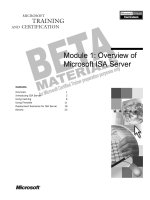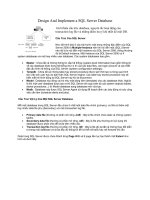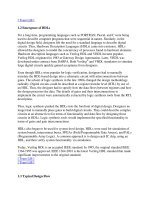Overview of Ericsson’s GSM Systems docx
Bạn đang xem bản rút gọn của tài liệu. Xem và tải ngay bản đầy đủ của tài liệu tại đây (273.86 KB, 16 trang )
Overview of Ericsson’s GSM Systems
Chapter 2
This chapter is designed to provide the student with an overview of
Ericsson’s GSM systems: CME 20 and CMS 40
OBJECTIVES:
Upon completion of this chapter the student will be able to:
• List 3 network components in Ericsson’s GSM system, and
briefly describe their function
• List 3 optional additional network entities and briefly describe
their function
GSM System Survey
EN/LZT 123 3321 R4A
ll
aa
n
n
k
k
B
B
i
i
o
o
n
n
a
a
l
l
l
l
y
y
t
t
n
n
e
e
t
t
n
n
I
I
2 Overview of Ericsson’s GSM Systems
EN/LZT 123 3321 R4A – i –
2 Overview of Ericsson’s GSM
Systems
Table of Contents
Topic Page
ERICSSON IN GSM 27
ERICSSON'S GSM SYSTEM ARCHITECTURE 28
ERICSSON’S SS IMPLEMENTATION 29
ERICSSON’S BSS IMPLEMENTATION 30
ERICSSON’S OMC AND NMC IMPLEMENTATION 32
ADDITIONAL ERICSSON NETWORK COMPONENTS 35
GSM System Survey
– ii – EN/LZT 123 3321 R4A
ll
aa
n
n
k
k
B
B
i
i
o
o
n
n
a
a
l
l
l
l
y
y
t
t
n
n
e
e
t
t
n
n
I
I
2 Overview of Ericsson’s GSM Systems
EN/LZT 123 3321 R4A – 27 –
ERICSSON IN GSM
Ericsson has been involved in GSM since its inception and took an
active part in the GSM specification process.
Ericsson is the largest supplier of GSM equipment in the world with a
market share of approximately 40%. Over 477 GSM networks
worldwide are supplied by Ericsson.
Ericsson, in partnership with Sony Corporation, is one of the leading
suppliers of GSM mobile phones and has sold around 390 million
mobile phones to date.
F Did you know?
Western Europe has
the highest
penetration for mobile
phones now 72%.
North America has
45% penetration.
GSM System Survey
– 28 – EN/LZT 123 3321 R4A
ERICSSON'S GSM SYSTEM ARCHITECTURE
Ericsson provides ?two systems for GSM networks:
• Cellular Matra Ericsson (CME) 20: for GSM 900 and GSM
1800 networks
• Cellular Mobile System (CMS) 40: for GSM 1900 networks
Like the GSM system model itself, Ericsson’s GSM systems are split
into two primary systems: the Switching System (SS) and the Base
Station System (BSS). However, depending on the requirements of a
network operator, Ericsson’s GSM systems can incorporate other
functions and nodes, such as Mobile Intelligent Network (MIN)
nodes, Flexible positioning nodes and post processing systems.
Note: Ericsson’s wide range of MSs are not considered to be part of
either the CME 20 or CMS 40 product, due to the fact that an MS
from any supplier can work with network equipment from any other
supplier.
Switching System
ILR
AUCEIR
Other
PLMNs
PSTN
ISDN
Public Data
Networks
TRC
BSC
RBS
MSC/VLR
SSF
Signaling Information
Speech and signaling information
Base Station System
DTI
MC
SDP
HLR
GMSC
OSS
SCF
MIN
BGW
SOG
Figure 2-1 Ericsson GSM network system model
F Did you know?
CME stands for
Cellular Matra
Ericsson, because the
French company
Matra was involved in
the initial
development of
Ericsson’s GSM
system.
2 Overview of Ericsson’s GSM Systems
EN/LZT 123 3321 R4A – 29 –
Basic or
Additional
Abbrev. System Full component name Platform
Basic MSC/VLR SS Mobile services Switching Center/Visitor
Location Register
AXE
Basic GMSC SS Gateway MSC AXE
Basic HLR SS Home Location Register AXE
Basic ILR SS Interworking Location Register AXE
Basic AUC SS AUthentication Center Unix/AXE
Basic EIR SS Equipment Identity Register Unix
Basic DTI SS Data Transmission Interface AXE
Basic TRC BSS TRanscoder Controller AXE
Basic BSC BSS Base Station Controller AXE
Basic BTS BSS Base Transceiver Station RBS
Basic OMC OSS Operation and Maintenance Center TMOS
Basic NMC OSS Network Management Center TMOS
Additional MC SS Message Center MXE
Additional SSP SS Service Switching Point AXE
Additional SCP SS Service Control Point AXE
Additional SDP SS Service Data Point Unix
Additional SOG Service Order Gateway Unix
Additional BGW Billing GateWay Unix
Table 2-1 Components of Ericsson network system
ERICSSON’S SS IMPLEMENTATION
Mobile services Switching Center/Visitor Location Register
(MSC/VLR)
The MSCs in all Ericsson GSM networks are AXE exchanges. In all
Ericsson GSM networks, the VLR is integrated into the MSC node.
This means that signaling between the VLR and the MSC is done
internally within the MSC/VLR network node and does not have to
be carried over the rest of the network. This has the benefit of
reducing the overall signaling load on the network.
Gateway Mobile services Switching Center (GMSC)
The GMSC is also implemented as an AXE exchange. In effect, it is
an MSC with some additional software.
GSM System Survey
– 30 – EN/LZT 123 3321 R4A
Home Location Register (HLR)
Ericsson’s HLR is also based on AXE and can be implemented in
the same node as the MSC/VLR or as a stand-alone node.
Interworking Location Register (ILR)
The Interworking Location Register (ILR) exists in CMS 40
networks only. An ILR makes inter-system roaming possible,
meaning that a subscriber can roam from a GSM 1900 network to
an AMPS network. The ILR consists of an AMPS HLR and a GSM
1900 VLR. In the near future the ILR will make intersystem roaming
possible in both directions between all GSM/AMPS/TDMA
networks.
Authentication Center (AUC) and Equipment Identity Register (EIR)
The AUC and EIR are implemented either as stand-alone nodes or
as a combined AUC/EIR node. The UNIX-based AUC and the EIR
are developed by Sema Group. The AUC may alternatively reside
on an AXE, possibly integrated with a HLR.
Data Transmission Interface (DTI)
The DTI is a hardware platform which implements the GSM-defined
InterWorking Function (IWF). It performs data handling functions
such as data rate conversion. DTI is implemented on an AXE
platform and is integrated in the MSC/VLR. Because it is integrated
into the AXE platform, the DTI does not need separate operation
and maintenance facilities.
ERICSSON’S BSS IMPLEMENTATION
Ericsson’s BSS differs slightly from the GSM system model, in that a
node called the Transcoder Controller (TRC) is added. However,
this does not provide extra functionality - the functions of the TRC
are part of the GSM model’s BSC.
Transcoder Controller (TRC)
The purpose of a TRC is to multiplex network traffic channels from
multiple BSCs onto one 64 kbits/s PCM channel which reduces
network transmission costs. The TRC can be combined with the
BSC or exist as a stand-alone node.
2 Overview of Ericsson’s GSM Systems
EN/LZT 123 3321 R4A – 31 –
Base Station Controller (BSC)
The BSC in all Ericsson GSM networks is based on AXE
technology. It can be implemented as a stand-alone node or
integrated with either an MSC/VLR or a TRC.
Base Transceiver Station (BTS)
In Ericsson's GSM systems the BTS is included as part of a product
called RBS. The RBS also contains extra functionality which enables
the support of several GSM-defined BTSs.
Ericsson offers a wide range of RBSs for use in GSM networks:
• RBS 2101
• RBS 2102
• RBS 2103
• RBS 2202
• RBS 2301
• RBS 2302
• RBS 2302 MAXITE
• RBS 2401
• RBS 3000 series implements the BTS for UMTS, also known as
WCDMA Systems.
GSM System Survey
– 32 – EN/LZT 123 3321 R4A
ERICSSON’S OMC AND NMC IMPLEMENTATION
Operation and Support System (OSS) is Ericsson’s product to
support the activities performed in an OMC and/or NMC. The
network operator monitors and controls the network through OSS
which offers cost effective support for centralized, regional and local
operations and maintenance activities. OSS is based on Ericsson's
Telecommunications Management and Operations Support (TMOS)
platform.
OSS is designed as a complete network management system which
can be used to control all the main network elements such as
MSC/VLRs, HLRs, ILRs, TRCs, BSCs, EIRs, AUCs and Mobile
Intelligent Network (MIN) nodes. OSS can also control BTSs
through the BSCs.
OSS uses a Graphical User Interface (GUI) enabling easier system
use and network management.
OMC OMC
HLR
AUC/EIR
TRC
MSC
BSC
BTS
Operation and
Support System
NMC
Figure 2-2 OSS provides central supervision of all network
elements
2 Overview of Ericsson’s GSM Systems
EN/LZT 123 3321 R4A – 33 –
Telecommunication Management Network (TMN)
OSS and TMOS are based on the international Telecommunication
Management Network (TMN) standard. TMN is a model for the
management of telecommunication networks. The most important
areas of network management identified by TMN are:
• Configuration Management
• Fault Management
• Performance Management
Configuration Management
In OSS, the cellular network can be displayed on screen using a
Graphical Cell Configuration (GCC). GCC gives a graphical view of
the entire network and allows the operation and maintenance staff to
zoom in on specific regions of the network to get a more detailed
picture of particular cells.
Figure 2-3 Graphical Cell Configuration
GSM System Survey
– 34 – EN/LZT 123 3321 R4A
Fault Management
The operator can monitor the status of the network by using
Network Alarm Status Presentation. If a failure occurs in the
network, one or more alarms are activated and forwarded to the
OMC. Different icons are depicted on screen to indicate the severity
of the alarm. One icon is used to show critical situations while
another icon is used to show warnings.
Figure 2-4 Network Alarm Status Presentation map showing
icons for different types of alarms
Performance Management
In order to plan for future use of the cellular network, each operator
must check the performance of the network. With performance
management it is possible for an operator to collect and receive
statistics based on both short-term and long-term measurements.
2 Overview of Ericsson’s GSM Systems
EN/LZT 123 3321 R4A – 35 –
ADDITIONAL ERICSSON NETWORK COMPONENTS
A basic GSM network can be enhanced by the addition of some or
all of the following functions.
Additional Nodes
Message Center (MC)
A Message Center (MC) may be added to a GSM network to
provide voice/fax mail and handling of the Short Message Service
(SMS) and SMS Cell Broadcast (SMSCB) text messages. These
services can generate considerable revenue for a network operator,
as they are becoming increasingly popular.
In the Ericsson GSM system the MC is implemented by Ericsson's
MXE product. Like other network nodes, the MXE can also be
controlled by OSS.
Mobile Intelligent Network (MIN) nodes
Mobile Intelligent Network (MIN) nodes can be added to a basic
GSM network to provide value-added services to subscribers.
Ericsson’s MIN nodes include:
• Service Switching Point (SSP): an SSP acts as an interface
between the call control functions of the mobile network and the
service control functions of a Service Control Point (SCP).
Ericsson's SSP is AXE-based and may be integrated within an
MSC/VLR (recommended) or stand-alone.
• Service Control Point (SCP): an SCP contains the intelligence
of a MIN service or services. This intelligence is realized in
software programs and data. Ericsson's SCP is also AXE-based
and the recommended configuration is as a stand-alone node,
accessible by all MSC/SSPs.
• Service Data Point (SDP): an SDP manages the data which is
used by a MIN service. Ericsson’s SDP is a stand-alone node
based on UNIX.
F Did you know?
Examples of MIN
services include:
• freephone
• premium rate
• personal number
• televoting
• cellular virtual
private network
GSM System Survey
– 36 – EN/LZT 123 3321 R4A
Flexible Positioning Support
Mobile positioning allows the operator to track the location of
subscribers. This allows the operator to increase revenue by
introducing new location based services and meet regulatory
requirements to locate subscribers who make emergency calls.
Figure 2.6 SMPC and Lb Interface
The type of service offered to the subscriber, and accuracy of the
location result, depend on the positioning method used.
Mobile Positioning functionality requires the introduction of new
hardware and software. The most important positioning node is the
Serving Mobile Positioning Center (SMPC) which determines which
positioning method to use based on:
• the accuracy requested
• the methods supported by the MS and the system.
The SMPC manages the overall coordination and scheduling of
resources to perform the positioning of the MS. One SMPC can be
connected to many BSCs.
2 Overview of Ericsson’s GSM Systems
EN/LZT 123 3321 R4A – 37 –
Post Processing Systems
Post-processing systems are used by network operators to analyze
the large amount of information generated by calls in the network.
Service Order Gateway (SOG)
A network operator requires administrative systems to analyze and
manage network information such as customer subscriptions, billing
information and for fraud detection. An operator's administrative
systems are normally called Customer Administration Systems
(CAS). They are complex systems which are often inflexible and
costly to adapt to the specific needs of individual network operators.
The Service Order Gateway (SOG) is an Ericsson product which
enables CASs to exchange information with network elements which
contain service information, such as the HLR.
MCHLR
Customer
Customer
Adm.
Adm.
System
System
OSS/OMC
OSS/OMC
AUC EIR ILR
SOGSOG
Figure 2-7 Service Order Gateway (SOG)
GSM System Survey
– 38 – EN/LZT 123 3321 R4A
Billing GateWay (BGW)
A Billing GateWay (BGW) collects billing information or Call Data
Record (CDR) files from network elements such as MSCs and
forwards them to post-processing systems that use the files as input.
A BGW acts as a billing interface to the network elements in an
Ericsson network and its flexible interface supports adaptation to any
new types of network elements. Any internal BGW alarms are
forwarded to OSS at an OMC.
A BGW is usually connected to the customer administration and
billing systems and is handled by the administrative organization.
The figure below shows some of the possible billing information
required when analyzing a specific call.
Collection = BGW, Billing Gateway
HLR
Customer
Customer
Adm.
Adm.
System
System
MSC
SOG
Provisioning = SOG, Service Order Gateway
MSC
BGW
AUC EIR
Figure 2-8 Billing information









